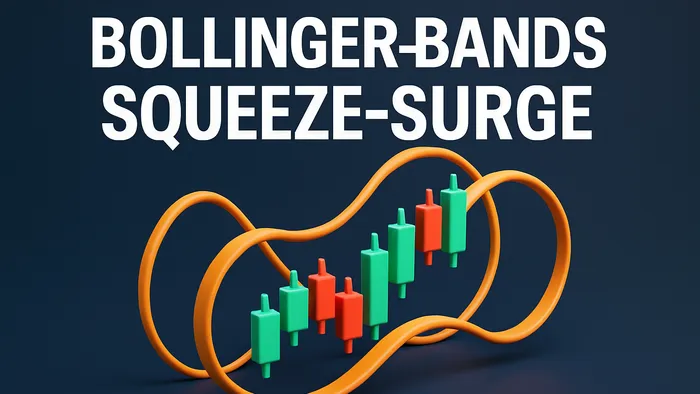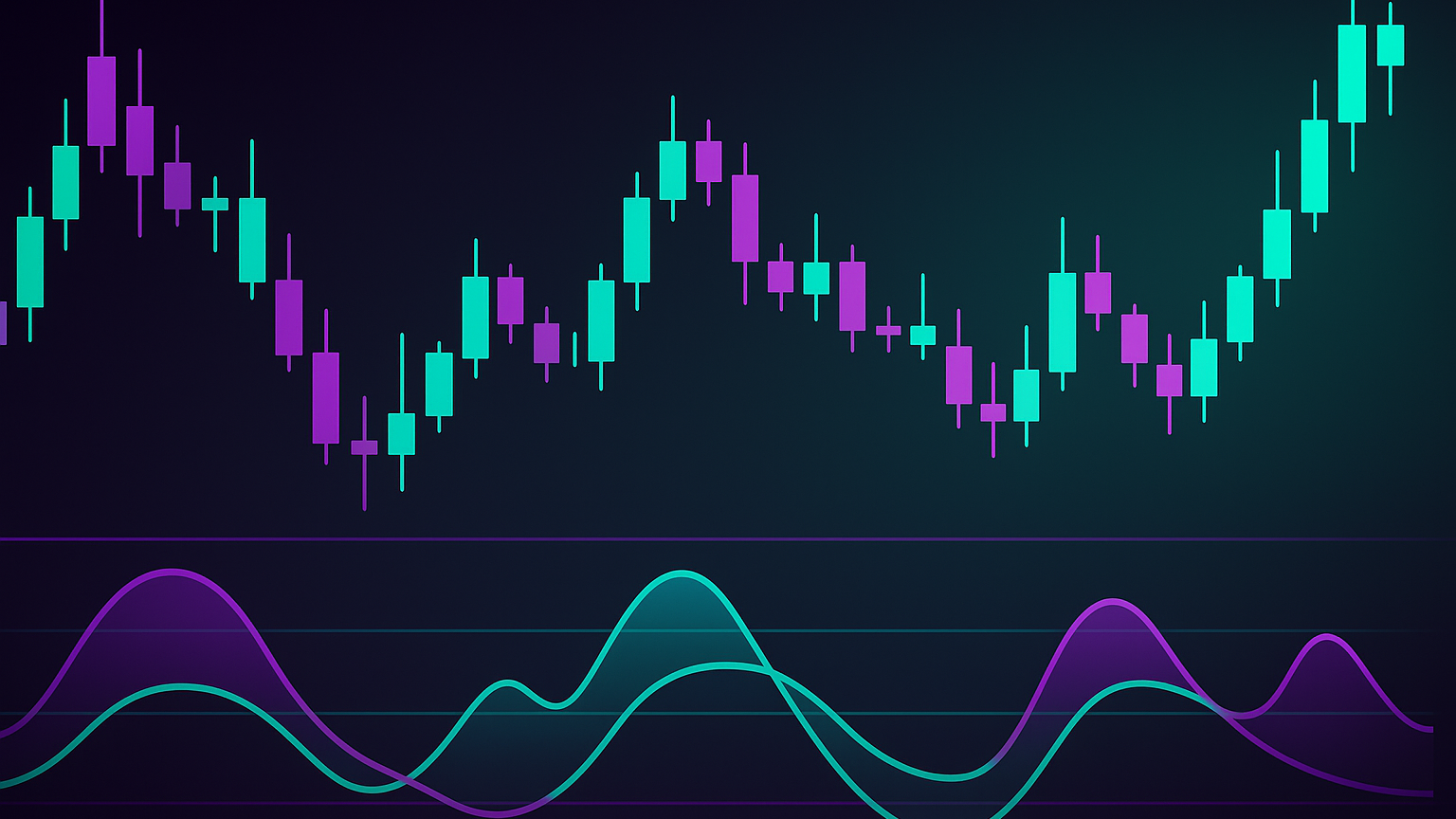Learn how the Bollinger Bands Squeeze-Surge strategy can help you identify market volatility and potential breakout opportunities for trading.
Want to predict market moves? The Bollinger Bands Squeeze–Surge strategy helps traders spot low-volatility phases (Squeeze) that often lead to sharp price movements (Surge). Here's how it works:
- Squeeze: Bands tighten, signaling reduced volatility and market consolidation.
- Surge: A breakout occurs, with strong price movement beyond the bands.
- Key Tools: Use indicators like BBW (Bollinger BandWidth), volume, RSI, and LuxAlgo Signals & Overlays toolkit to confirm breakouts.
- Risk Management: Protect trades with ATR-based stop losses and multi-timeframe analysis.
This strategy works across markets and timeframes but requires patience and confirmation to avoid false breakouts.
John Bollinger: Bollinger Bands Squeeze, Bulge
How to Spot a Squeeze Pattern
To identify a squeeze pattern, focus on chart features and specific measurements.
Recognizing Band Patterns
A squeeze happens when Bollinger Bands tighten significantly around price movement. Look for these signs:
- Band Width: Bands steadily move closer together.
- Price Movement: Price stays confined within the narrowing bands.
- Duration: The compression develops over multiple trading periods.
Calculating Band Compression
The Bollinger BandWidth (BBW) indicator helps measure the squeeze by showing the percentage difference between the upper and lower bands compared with the middle band.
BBW = ((Upper Band − Lower Band) / Middle Band) × 100
Track BBW over 8 to 12 months to identify when it approaches historically low levels, indicating reduced volatility.

Leveraging LuxAlgo Tools

LuxAlgo Signals & Overlays toolkit simplifies spotting squeeze patterns by offering:
- Automatic detection of squeezes across different timeframes
- Visual displays of band compression
- Custom alerts for squeeze setups
- Filters to assess the quality of setups
The Price Action Concepts toolkit, combined with Signals & Overlays, helps validate patterns. Use these tools with support or resistance levels, volume analysis, and market context to improve trading decisions.
Once you confirm a squeeze, watch for breakout signals as the market enters the surge phase.
Trading the Surge Breakout
After identifying a squeeze pattern, the next step is to act on breakout signals while steering clear of false moves.
Breakout Direction Signals
A legitimate breakout is marked by clear price movement. Look for:
- A strong candle that closes well beyond the Bollinger Band, not just a slight breach.
- Increased trading volume that confirms the move.
- Alignment with key levels, such as support or resistance zones.
LuxAlgo’s toolkits can simplify this process by providing real-time alerts to validate breakouts. Once confirmed, manage risk with precise stop-loss strategies.
Trade Protection Methods
Protect trades using ATR-based stop-loss levels:
- Use a 2.0 × multiplier for normal market conditions.
- For high volatility, increase to a 2.5 × to 3.0 × multiplier.
A dynamic method like the Chandelier Exit can help. For long trades, set your stop loss at the highest high since entry minus (ATR × multiplier). For short trades, use the lowest low plus (ATR × multiplier).
| Market Condition | ATR Multiplier | Example Stop-Loss Distance |
|---|---|---|
| Normal Volatility | 2.0 × | About $4.00 below entry |
| High Volatility | 2.5 × – 3.0 × | About $5.00 – $6.00 below entry |
During volatile periods, adjust your ATR multiplier to account for larger swings. If price moves in your favor by roughly 2 × ATR, tighten the stop loss to lock in profits while allowing room for growth.
Spotting False Breakouts
Confirm signals with multiple indicators to avoid false breakouts.
"Combine the Bollinger Band Squeeze with complementary indicators like RSI, MACD, or volume analysis to filter out false signals and confirm genuine breakout opportunities." – Mind Math Money
LuxAlgo Signals & Overlays toolkit can help identify false breakouts by analyzing:
- Differences between volume and price movement
- Momentum indicator alignment
- Price-action patterns that often signal failed breakouts
- Interactions around critical support or resistance levels
Before major economic announcements, consider widening stop-loss settings to handle the increased volatility. Always wait for clear confirmation before entering a trade.
Step-by-Step Trading Guide
This guide shows how to trade effectively by building on breakout identification techniques.
Finding Squeeze Setups
Use LuxAlgo Signals & Overlays toolkit to spot squeeze setups when Bollinger Bands contract significantly.
- Look for noticeable narrowing of Bollinger Bands.
- Ensure BBW is near a six-month low, with contraction over multiple periods.
- Leverage LuxAlgo Price Action Concepts toolkit to automate detection across timeframes.
Checking Trade Setup Quality
After spotting a potential squeeze, assess its quality with multiple confirmation tools. The Oscillator Matrix toolkit adds momentum and trend context.
| Confirmation Factor | What to Look For | Why It Matters |
|---|---|---|
| Volume Profile | Decreasing volume during squeeze | Suggests authentic consolidation |
| Price Location | Near key support or resistance | Improves likelihood of breakout |
| Trend Context | Aligns with overall trend | Indicates probable breakout direction |
Once the setup checks out, proceed to trade entry and management.
Trade Entry and Management
For entry, wait for a strong breakout candle that moves beyond the 20-period SMA (2 standard deviations). Adjust criteria for market conditions.
- Entry Timing: Enter only on a clear breakout candle.
- Position Sizing: Base size on current BandWidth; tighter bands often precede higher volatility.
- Stop-Loss Placement: Place your initial stop just below the opposite Bollinger Band for breakout trades. Adjust it as the trade progresses to lock in profits while allowing natural price movement.
"The Bollinger Band Squeeze identifies periods of low volatility that often precede significant price movements – making it an effective tool for anticipating breakouts." – Mind Math Money
Use LuxAlgo Custom Alert Creator to monitor squeeze formations and breakout signals.
Strategy Strengths and Weaknesses
Strategy Performance Review
This strategy excels at identifying potential opportunities but faces challenges, particularly with false breakouts.
| Strength | Weakness |
|---|---|
| Spots opportunities before significant moves | Prone to false breakouts |
| Performs well during shifts from low to high volatility | Struggles in consistently volatile or range-bound markets |
| Offers clear visual cues through band contraction | Predicting squeeze duration and breakout direction can be tricky |
| Can be automated with technical-analysis tools | Effectiveness varies across market conditions |
| Works across timeframes and asset classes | Requires patience during prolonged squeeze phases |
Managing Trading Risks
Manage risks through disciplined position sizing, multi-timeframe analysis, and clear breakout signals:
Position Sizing
Start with smaller positions and increase only after confirming breakout direction.
Multiple Timeframe Analysis
Validate squeeze patterns across timeframes to strengthen signals.
Volatility Adjustments
For highly volatile assets, widen stop-loss levels and reduce position size.
Risk Mitigation Techniques
- Use RSI or MACD, plus market context, to confirm breakouts.
- Place stop-loss levels near the opposite Bollinger Band.
- Scale down position size during uncertain market conditions.
Market Environment Assessment
Backtesting shows the strategy performs best when volatility shifts from low to high. In prolonged high-volatility periods, adjust entry criteria and position sizes accordingly.
Summary
Key Points of the Bollinger Bands Squeeze–Surge Strategy
The strategy provides a structured way to approach major market movements. Key components:
Identifying Patterns
- Spot noticeable band tightening that signals reduced volatility.
- Watch for breakout signals with strong candle closes beyond bands.
- Confirm breakouts at key support or resistance levels.
Validating Signals
- Use volume, RSI, or MACD to confirm breakout strength.
- Analyze volume trends to gauge reliability.
- Incorporate chart patterns to filter false signals.
Managing Risk
- Start with smaller positions during squeeze phases.
- Increase size only after confirming breakout direction.
- Place stop-loss orders at clear levels.
- Adjust size based on market behavior.
Tips for Getting Started
Use LuxAlgo toolkits to implement these principles:
Setting Up Your Trading Platform
- Identify squeeze patterns with Bollinger Bands.
- Confirm breakouts with additional indicators.
- Validate trend direction before acting.
Refining Your Strategy
- Backtest the approach under various conditions.
- Leverage the AI Backtesting Assistant to fine-tune entries and exits.
- Stay updated with real-time alerts for potential setups.
The strategy works best during shifts from low to high volatility, so tailor your approach to the market’s current behavior.
FAQs
How can I tell if a breakout is genuine or false when using the Bollinger Bands Squeeze–Surge strategy?
Focus on these indicators to distinguish genuine breakouts from false ones:
- Candle Close: A true breakout shows a strong candle closing well beyond the upper or lower band.
- Volume Confirmation: High trading volume during the breakout supports its validity.
- Support and Resistance: Breaking a significant level adds credibility.
For added accuracy, combine this strategy with RSI or MACD before acting.
How does the Bollinger BandWidth (BBW) indicator help identify a squeeze pattern, and how can traders use it effectively?
The BBW indicator measures the gap between the upper and lower Bollinger Bands. When bands tighten, indicating low volatility, BBW values decrease, signaling a potential squeeze.
Watch for unusually low BBW values, which suggest consolidation often followed by a breakout. Monitor BBW alongside complementary indicators to confirm signals.
How can I manage risk effectively when trading during a breakout in volatile markets?
Use ATR-based stop-loss levels, setting them at 1.5 × to 3 × ATR to allow for larger moves. Consider trailing stops such as a chandelier exit to adjust dynamically.
Adjust position size according to volatility: Position Size = (Amount at risk) / (ATR-based stop distance). Diversify across unrelated markets to reduce overall risk.








